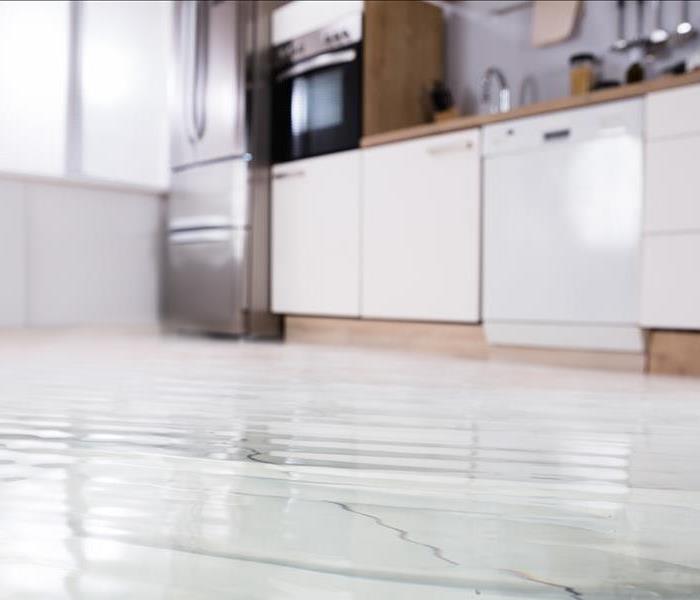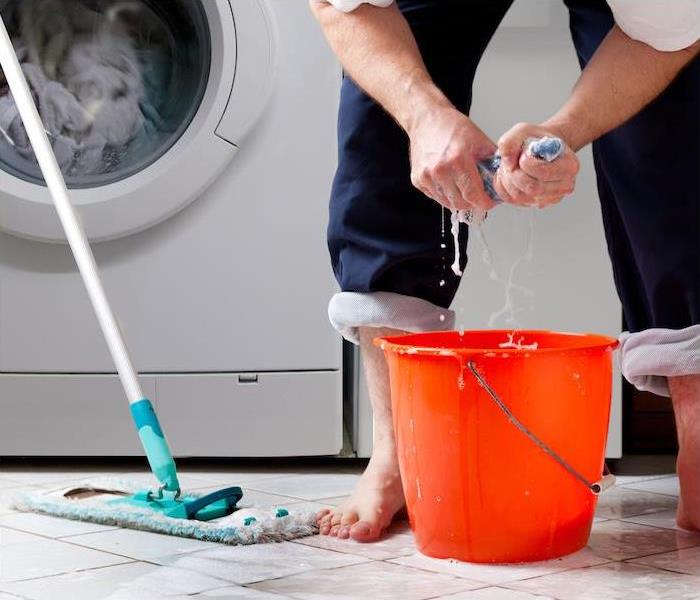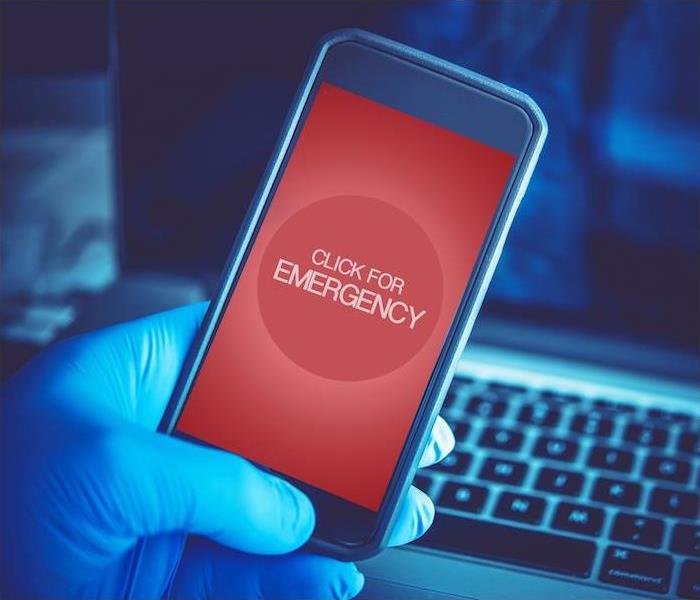Recent Water Damage Posts
Defend Your Property From Water Damage in the New Year | SERVPRO® of Van Nuys South
1/11/2023 (Permalink)
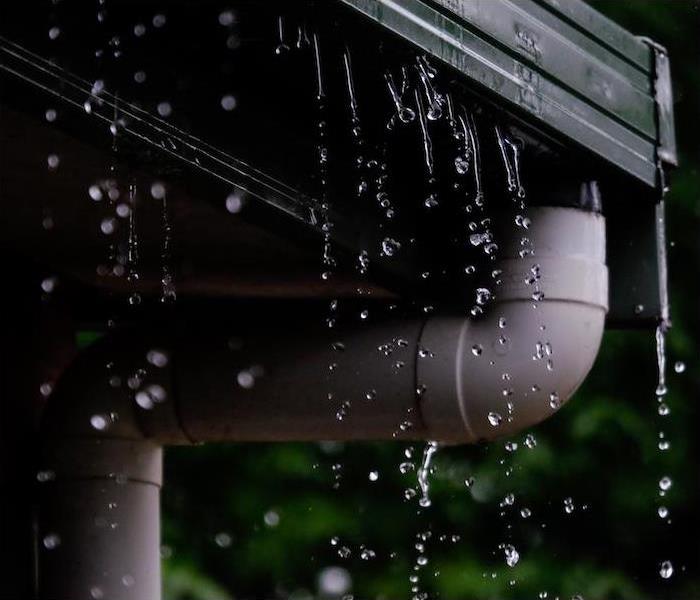 Have water damage in your home? Contact SERVPRO of Van Nuys South for quick and professional restoration.
Have water damage in your home? Contact SERVPRO of Van Nuys South for quick and professional restoration.
There is no better time to make a change than the start of a new year. Whether you are hoping to make some changes to your daily routine or you want to take on a new project, there is so much room for growth and improvement.
If you’re wanting to tackle home improvement in the new year, waterproofing your home is a great place to start! Preparing for water damage could save you from extensive and costly repairs while also providing you with peace of mind that your home is safe and dry.
Here’s how you can make substantial improvements to keep your property safe in the new year:
What Causes Water Damage?Knowing the main areas where water can enter your home should be your first step in the waterproofing process. Leaks can show up both inside and outside.
Household appliances and bathroom fixtures are frequent causes of water damage within your residence, while clogged gutters and rainwater runoff are outside threats that find their way inside.
Your home may potentially experience moisture problems due to tattered pipes or caulking that has corroded away from windows and doors. Leaks that go unnoticed might result in mold development and ruined walls or flooring.
When water starts leaking into your appliances, they can also start to corrode or stop running altogether. Finding your problem at its source is the best method to mitigate property damage.
How to Prevent DamageWater damage can turn into a chaotic mess quickly, so regular maintenance and inspection are the keys to preventing damage. Catching a leak early on will always be the most effective way to keep a water damage emergency from getting any worse.
Get in the habit of routinely inspecting your bathrooms and kitchen for puddled water or indicators of mold to keep water at bay. When it’s raining, check your windows to make sure water isn’t leaking inside by checking for dampness.
You should also upkeep your roof often (and following any severe wind events) for damage like loose or missing shingles. And while you’re up there, clear your gutters and downspouts of debris to prevent a clog.
Inspecting your roof on a regular basis will also be advantageous when water damage-causing weather conditions approach our area. Floods are common in Van Nuys, and they can take several forms, including coastal or river flooding and nearby tsunamis.
Flood preparation may appear to be a big chore, but knowing your local flood risk, monitoring the weather and continuing your routine water damage maintenance can be greatly beneficial when preventing water damage.
You can spare yourself from expensive and lengthy repairs by incorporating a few simple changes to your daily maintenance routines. And you’ll have one more thing to mark off that resolution list!
Have water damage in your home? Contact us for fast, professional restoration back to preloss condition.
Different Ways That Water Seeps Inside Your Home | SERVPRO® of Van Nuys South
12/7/2022 (Permalink)
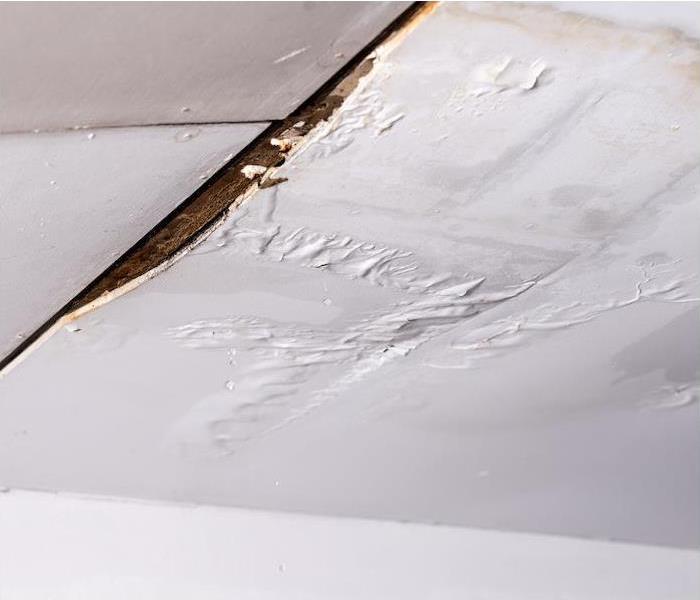 If you experience any water damage inside your home or business, reach out to SERVPRO of Van Nuys South.
If you experience any water damage inside your home or business, reach out to SERVPRO of Van Nuys South.
Water seepage is sneaky and may go unnoticed, but there are indicators you should be looking for. Worsening air quality indoors and a musty smell are two major red flags, but peeling paint and warped flooring are other signs of moisture getting inside.
The moisture can also rust metal appliances, but there are many signs of moisture-related issues that you need to be aware of.
Water damage is a serious problem that can cause major damage if left unaddressed. Read on to see how moisture gets inside and some potential solutions for you to take.
Water Fixture LeaksYour home’s water fixtures are not without fault, and holes in your water supply lines often allow moisture to seep out unexpectedly. Look near the shower, bathtub, sink or toilet for this issue.
Inspect these spots during your cleaning routine, and take action against leaks immediately to prevent thousands of gallons of water from entering your home each year.
Water From AppliancesYour refrigerator is another sneaky source of leaks due to its water supply and ice maker. Dishwashers are a frequent cause, and these leaks often occur over long periods, resulting in serious damage that escalates as time goes on.
Check your appliances for leaks by unplugging them and pulling them out carefully. Look at the surrounding building materials for signs of mold or moisture, and contact our team if you notice something wrong.
External SourcesWater can also come from outside the home, with many leaks resulting from gaps in your window frames or doors. It’s also possible for a storm to cause minor damage that can allow water indoors.
It’s no surprise that we, as Californians, see a minor 17 inches of rainfall annually, leaving many wondering if they should prepare for external sources of water damage at all. Just because our risks in Van Nuys are lower, though, doesn’t mean we should ever ignore the possibility of a natural water disaster coming through our region.
While leaks can come from everywhere, there are steps you can take to manage them. Setting your home up properly and maintaining it can help you fight off moisture before it gets indoors.
Monitor the gutters and downspouts around your house, as clogging will stop the water flow and allow it to pool on your roof. Beyond this, check your roof after each weather event to spot minor damage that could allow water to seep inside from the top down.
Check the seals on your windows and doors, and replace any degraded ones to prevent water from getting indoors in this manner. Lastly, your property’s landscaping affects how water might get inside your living space. Enact techniques that can direct water away from your home to prevent it from flowing around and inside.
If you experience water damage inside your home or business, call us, 24⁄7. We have the experience and equipment to get your property back in working order fast.
Protect Your Property & Stop Floodwater in Its Tracks | SERVPRO® of Van Nuys South
9/8/2022 (Permalink)
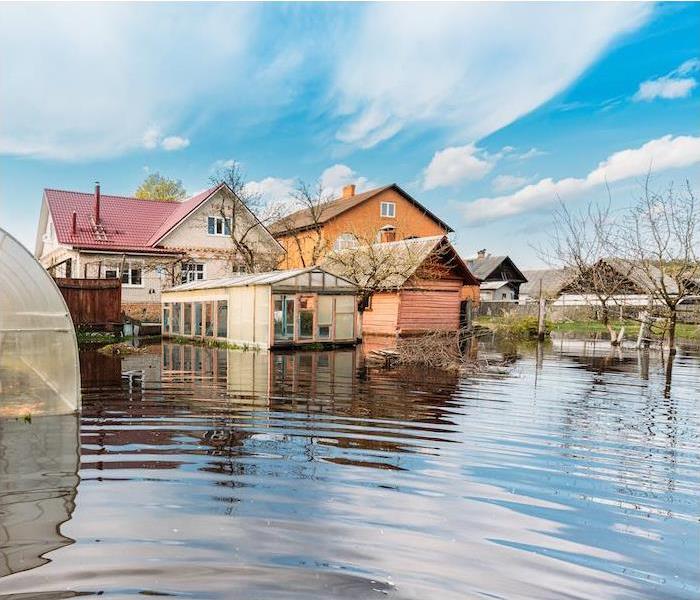 Experienced water damage in your home? Call SERVPRO of Van Nuys South to get the restoration process started right away.
Experienced water damage in your home? Call SERVPRO of Van Nuys South to get the restoration process started right away.
Everyone needs to take steps toward flood protection because even low-risk areas can suffer serious consequences with just an inch of floodwater. You can protect both the interior and exterior of your home, but it all begins with understanding our region’s risks.
Here in California, we aren’t nearly as vulnerable to flooding as some other places in the country, but we still face serious risks. Wildfires create layers of ash on the ground that prevents it from absorbing rainfall, which means we can experience deadly flooding even from a minor downpour.
Additionally, our emergency services are not as adapted to flooding as other regions of the country, so it may take longer to receive help during a disaster.
Once you know the kinds of disasters we may face here, you can begin to prepare for them the right way.
Protecting Your Home From the OutsideEveryone should understand the variability of weather, especially in our region. This means you could experience a heavy downpour that could flood your property in under 30 minutes. However, you can mitigate the effects by taking time to prepare your house for flooding.
Clean your gutters out regularly, and consider using landscaping techniques that direct water away from the structure of your home. You can also create one or more rain gardens around your property that will absorb excess water, keeping it away from your house.
Utilize this information before our next flood to keep your home and your household safe from the dangers.
Flood Protection From the InsideOnce the outside of your home is safe, it’s important to protect the inside of the home as well. This begins by inspecting your foundation and sealing any cracks that may exist, no matter how small.
Flooding can also happen because of hazards inside your home like faulty plumbing, but performing standard home maintenance can keep your pipes in working order. You should check for leaks throughout your home and install leak detectors in areas with frequent moisture.
A flood is a dangerous event regardless of how it starts, so it’s crucial for you to prepare ahead of time to keep your home above water. To be most prepared, practice an emergency plan with your family and remember to follow it during the next storm so everyone can stay safe from the potential flood.
Experienced water damage in your home? Call SERVPRO today to get your restoration completed faster.
Knowing Your Storm Alerts Could Save You From Disaster | SERVPRO® of Van Nuys South
7/14/2022 (Permalink)
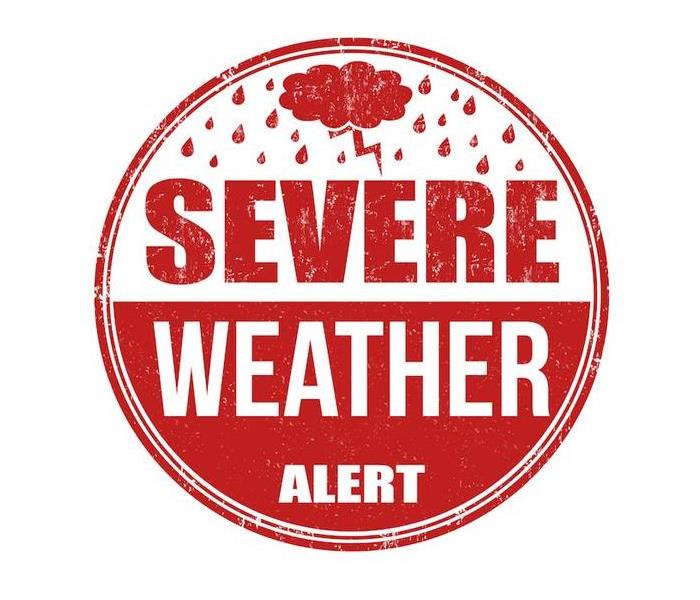 If you suspect any damage to your home from a recent storm, call SERVPRO of Van Nuys South.
If you suspect any damage to your home from a recent storm, call SERVPRO of Van Nuys South.
In our country, there are 42 different kinds of weather alerts that are used for various events across seven categories. During a storm, you won’t have much time to read through paragraphs about what each alert means because you’re preparing for what could be a dangerous storm.
By knowing what a warning, watch or advisory means for each event, you can be more prepared for the damage that they might cause. In addition to understanding the alert system, there are steps you can take to keep your home safer from damage as well.
While everyone should have knowledge of all kinds of weather, it’s most important to learn about the events we commonly see here in Van Nuys.
How Alerts Are IssuedDo you know how weather alerts are issued and planned? Well, the process is complex and affected by multiple factors. Weather forecasts make a prediction, but the severity, location and size of the storm require a lot of data to understand.
The National Weather Service is the main organization responsible for forecasting, collecting data, and issuing warnings. They have split the country into six categories, each with its own headquarters, along with hundreds of local offices. In the San Fernando Valley region, we fall under the Western Regional headquarters, which gives us highly specified alerts year-round.
The NWS has many employees, including meteorologists and astronomers who collect data and formulate forecasts for the country. They use information from satellites, seismic meters and even the sun’s activity to create the most accurate predictions possible.
The Most Important Alerts to UnderstandA “watch” and a “warning” are the most basic kinds of alerts, and everyone should know what they mean. These terms are used during nearly all weather events, including floods, thunderstorms and winter storms.
A watch is an indicator that storms in the area could potentially become dangerous and threaten your area. These are usually issued for large areas, as the goal is to get everyone aware of the possible danger.
Warnings are used when danger is coming fast, and these are typically relegated to a small area like a single city or county. When a warning is issued, you should take steps to be safer by following your local officials.
Besides knowing your various kinds of alerts, it’s important to recognize the weather that we see frequently to better prepare for the damage. We don’t see much rainfall annually, with only 22 inches on average, but this means that our infrastructure is not set up to handle these problems.
Even though the level of rain we see is below national averages, it’s important to be prepared because you never know when a dangerous storm might strike.
Protecting Your Home During a StormBesides knowing your emergency alerts, you can make efforts to prepare your home and mitigate potential damage to your property from weather events.
Clearing your gutters and securing your outdoor furniture is a great place to start. Outdoor furniture is often lifted up by powerful winds and then thrown into the home’s walls, roof or windows.
When the storm is gone, you should take plenty of photos or videos of the damage that your home has suffered. Afterward, give us at SERVPRO of Van Nuys South a call. We’re always ready to jump into action and help you get back on your feet.
Learn the weather most common in our area, and pay attention to weather alerts so you can be prepared for the dangers ahead.
Experienced storm damage to your home or property? Contact us today for a quick response!
How Water Damage Affects Your Home or Business Over Time | SERVPRO® of Van Nuys South
5/16/2022 (Permalink)
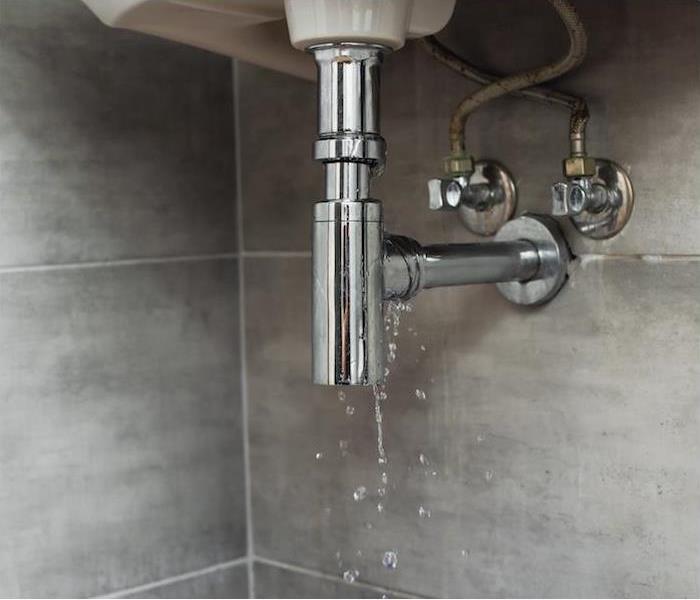 SERVPRO of Van Nuys South is your 24/7 water restoration expert. Call us right away if you need immediate service.
SERVPRO of Van Nuys South is your 24/7 water restoration expert. Call us right away if you need immediate service.
When moisture spreads inside the walls and floors of your home, the events can be disastrous. Many homeowners overlook the clear indicators that water damage is taking place, like a leaky faucet or water spots on the walls and ceilings.
Household leaks don’t seem overly important, but an average household leak can waste up to 10,000 gallons of water in a year.
Weather-related problems may not seem like a huge problem in California, but manmade water damage often does just as much destruction as natural disasters. So while you may not have to worry about hurricanes, a leaky pipe could be slowly degrading your home or business.
Excessive moisture allows the damage to progress rapidly by seeping into walls, floors and any soft surface. Identifying the problem and handling it immediately is the only way to produce the best results at the cheapest cost to you.
We’ve compiled a timeline of how water damage affects your home:
In the First 24 Hours
If you live in a house in a high-risk area, there is a one in four chance of a flood damaging your home within a 30-year period. Knowing what to do next is essential.
Once water damage affects you, it’s important to act quickly during the initial 24 to 48 hours to protect your home from further destruction. There are many items located in the home that will immediately be at risk of damage.
Soft furniture, carpet, rugs and upholstery will absorb water fast. Wooden structures, supports and furniture will begin to soak through and can end up swelling drastically.
Unfortunately, many personal items like clothing, books, photos and documents are especially vulnerable to the effects of water.
It’s best to keep these items located in waterproof containers or higher on shelves and in closets to reduce the risk of losing them. If you aren’t prepared and your personal belongings do suffer water damage, it’s essential to act quickly.
Our SERVPRO experts specialize in restoring your items instead of merely replacing them, which can save you money while protecting your precious valuables. If there is anything that we cannot restore, you’ll be notified immediately and these items will be removed to prevent the spread of moisture.
Within the First Week
Once the water has been present for longer than 24 hours, the damage accelerates and goes deepr into your building. Mold growth can explode at this point when excessive moisture is left unaddressed, potentially affecting your home’s structure.
Even worse, any porous surfaces like drywall, wood flooring, studs and walls will lose structural integrity and be at an increased risk of collapse. Metal surfaces, piping and appliances will begin to corrode and suffer severe damage during this period as well.
After One Week
After water and excessive moisture has been left to sit for extended periods, there will likely be catastrophic damage to your belongings and potentially to the structure of your home. Many homes that are left to suffer in water for this long have irreversible damage.
As time goes on, the costs and efforts to restore the structure will increase significantly, and the risks associated with structural damage are much greater.
How SERVPRO Will HelpAt SERVPRO, our unique restoration process will begin with a phone call, ideally inside the 24-hour mark. We then begin our service work by thoroughly extracting any standing water inside or around the home.
This step helps stop moisture from spreading further into your home, and reduces the overall drying time.
Odds are that floors, furniture and any other affected belongings, like clothes, will need a deep-cleaning, sanitizing and deodorization. Once we have removed as much water as possible, we send in our expert specialists with industry-leading equipment that can remove the water you can’t see.
After these initial steps, your home may need construction work to get your property back to its preloss condition. This step could include minor repairs or rebuilding entire areas of your home.
By choosing SERVPRO, we’re able to simplify the restoration process for you like no one else. We handle both the initial damage mitigation, and tackle the rebuilding of any affected areas.
We know that your input is important, so we keep you up to date through every step of the process. As always, our main goal is to have you back in your newly restored home or business as soon as possible.
Regardless of the type of water damage sustained, SERVPRO has the tools and teams to help your home or business recover. Contact us 24⁄7 when you need a dependable team to help you recover.
How To Replace a Toilet
3/2/2022 (Permalink)
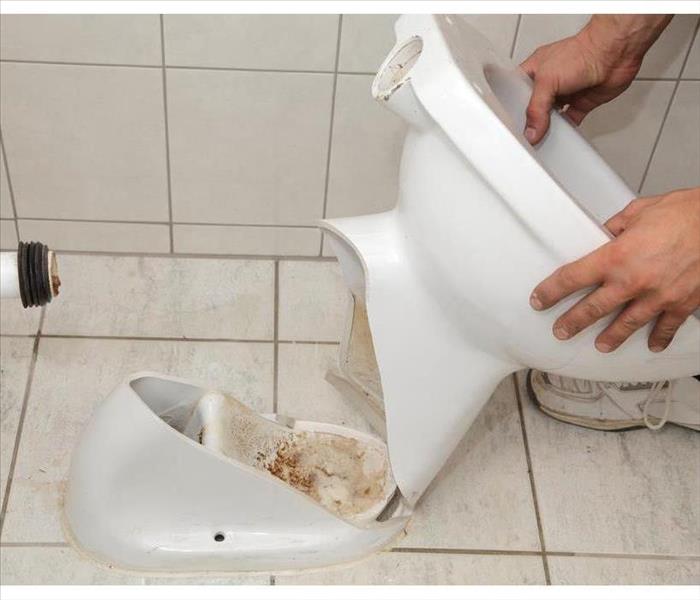 Over time, a leaking toilet can cause problems and require help from a water damage specialist.
Over time, a leaking toilet can cause problems and require help from a water damage specialist.
What Is The Best Way To Replace A Toilet?
Over time, a leaking toilet can cause problems and require help from a water damage specialist. Sometimes you can remedy the situation by replacing a faulty component. However, if your toilet repair is unsuccessful, replacing the entire unit may be your only option. Although the task may seem intimidating, the process is typically straightforward. Following a few essential guidelines can help you successfully accomplish this home improvement project.
Measure Before You Begin
Before installing a different commode, you should verify that the new device can fit into the allocated space. To accomplish this, complete a few important measurements:
- Distance from the back wall to the floor bolts
- Space between the current bowl and side walls
- Distance from the tank to water supply lines
Remove Existing Toilet
Disconnecting a leaking toilet can be messy. To minimize water seepage, you should complete the following steps:
- Turn off the water supply
- Flush commode to remove fluid
- Absorb remaining liquid with a sponge
- Place a bucket under tank before removing supply line
To disassemble your old toilet, unscrew the tank from the bowl. Then, loosen and remove the nuts holding the unit to the floor and place the detached commode on a garbage bag. You should also remove the old wax ring and any excess wax remaining along the top of the drain.
Set up New Toilet
Before connecting your new unit, you should install new floor bolts and place a new wax ring on the base of the toilet outlet. Then, lower the bowl over the new bolts, pushing it straight down to prevent ring damage. Once the base is firmly in place, secure the nuts. To prevent cracks, avoid overtightening.
After installing the base, carefully attach the tank. You should ensure the unit is level, and then reconnect the water supply. Before finalizing the project, verify the absence of leaks and adjust components as necessary.
A Simple Project
Replacing an old, leaking toilet with a new model doesn’t have to be a hassle. Measuring before commencing the project and taking steps to minimize water seepage can help every homeowner in Van Nuys South, CA, efficiently accomplish the task.
Tips for Cleaning Personal Belongings After Water Damage
1/27/2022 (Permalink)
 When you find water damage in your home, be sure to call the trained experts at SERVPRO for cleanup and restoration services.
When you find water damage in your home, be sure to call the trained experts at SERVPRO for cleanup and restoration services.
Cleaning Your Personal Effects After Water Damage
Following water in a home in Lake Balboa, CA, your affected belongings should be properly cleaned to prevent issues from making the situation worse. It is also important that you know when items are not able to be saved. Executing the cleaning process quickly following a broken pipe or another situation that caused water problems can ensure that you are able to preserve as many of your possessions as possible and get them adequately cleaned.
Items To Throw Away
Not all items can be saved after water in a home causes damage. Knowing what you should throw away can make this process a bit easier, saving you valuable time by not wasting energy trying to clean what cannot be saved. These are items that are usually good to toss:
- Medicines and supplements
- Food items touched by the water
- Wood that has become completely soaked
- Personal hygiene items touched by the water
- Anything with mold growth
Bedding and Clothing
Dry cleaning is a common method used to clean bedding and clothing items after they experienced water damage. It is typically best to take the items to a professional dry cleaner and let them know why they are being cleaned. They can then use the most effective products and methods for the job.
Solid Items
Items made of materials such as plastic, glass and metal can often be cleaned using a low-suds detergent. Then once you scrub them completely, simply use a sanitizer to help make sure that they are safe to use and touch. For solid materials such as wood, if water did not penetrate it, you can use this cleaning method, but if penetration did occur, you may not be able to save it.
You can surely see that following water in a home, there is a lot of work to be done. Use this information as a guideline to save as many of your personal belongings as possible while also ensuring that you get them completely clean.
Water Heaters: What You Might Hear and What To Do About It
11/29/2021 (Permalink)
 If you wake up to a groaning, rumbling water heater, there's a very good chance something is wrong.
If you wake up to a groaning, rumbling water heater, there's a very good chance something is wrong.
What You Might Hear About Water Heaters and What You Can Do About It
If you wake up to a groaning, rumbling water heater, there's a very good chance something is wrong. The bad news is that ignoring the problem could lead to very expensive repairs. The good news is that you can usually identify the problem and work with Valley Glen, CA, residential plumbing professionals before the situation gets too expensive.
Popping
Those pops generally indicate too much sediment in the tank. Solid materials, such as sand or minerals, often settle to the bottom of the heater tank. The popping is the result of lime-scale build-up, mineral deposits, or floating sediment. A water heater flush should take care of the problem. Sometimes a reaction between water with high pH levels and an aluminum anode rod causes a popping sound. Switching to a magnesium anode rod could solve the problem.
Rumbling
This ominous sound indicates the presence of so much sediment that your water heater could quit working very soon. The rumbling usually occurs because water expands as it is heated and forces the sediment to move around. If you hear rumbling, contact a Valley Glen, CA, professional right away.
Sizzling
This may be a great sound when you're making breakfast, but if you hear hissing or sizzling in your water tank, the heating element is probably covered in sediment. This problem is often remedied by draining the tank and then removing and cleaning the element. Sizzling could also indicate restricted water flow. Check all of the valves. If the T&P relief, or safety, valve is hissing, shut down the heater and contact a professional.
Ticking
Pressure fluctuations are usually the cause behind ticking noises. Take a look at water inlet and outlet fittings; these hook-ups could be the culprits. If you're not sure how to find these hook-ups, check with a local professional.
Too much sediment in the water heater is a common cause of many annoying noises but isn't the only problem likely to occur. If you can't quickly pinpoint the problem, contact a professional for more help.
How To Handle a Toilet Overflow
9/23/2021 (Permalink)
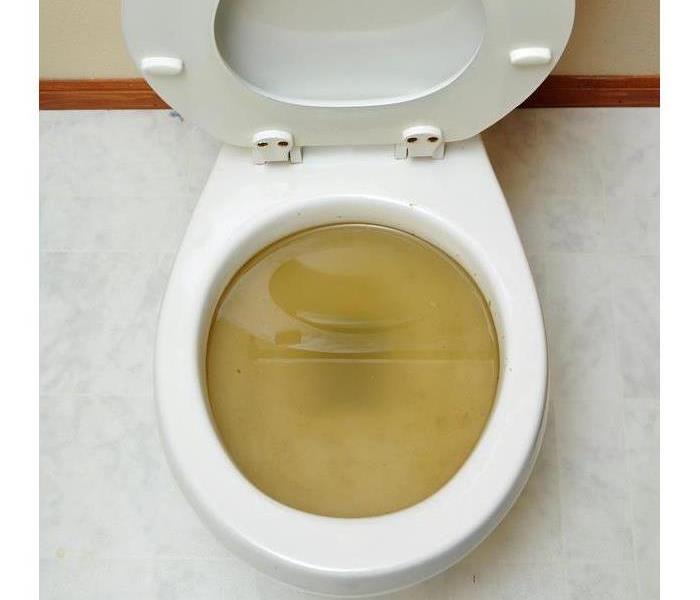 Depending on the extent of the leak caused by a flooded toilet, you can contact SERVPRO.
Depending on the extent of the leak caused by a flooded toilet, you can contact SERVPRO.
How To Deal With A Toilet Overflow
You should act quickly after a toilet overflows to limit the secondary damage caused by a sewage leak. Depending on what category of water is involved, the risk of sewer damage goes up. If the leak is large and involves black water, you may need to call a sewage company that provides restoration services in Van Nuys South, CA, as well as a plumber. Find out about the three different categories of water and simple steps you can take to fix a flooded toilet and clean up the mess.
There are three categories of water in a leak scenario:
- Clean water: Clean water should simply be removed and the area of the leak should be thoroughly dried.
- Gray water: Gray water includes the water from appliances such as washing machines and toilet water that only contains urine. Cleaning and disinfection are important steps.
- Black water: Black water contains contaminants with microbes and may pose a threat of infection to individuals with compromised immune systems. Leaks involving black water should be dried and disinfected as soon as possible, ideally within 24 hours.
As soon as you realize that a toilet is overflowing, you should try to see if you can handle the clog on your own with a plunger. If you cannot, minimize the extent of a leak by using towels to prevent water from spreading and contact a plumber. Once a plumber solves the underlying issue, it is up to you to limit the extent of secondary sewer damage or call on experts to completely restore the affected area.
Depending on the extent of the leak caused by a flooded toilet, you may want to contact a sewage company that specializes in restoration. Look for a cleaning and restoration service that specializes in sewer damage in Van Nuys South, CA, if you are concerned about lingering unwanted smells or the risk of mold.
The Importance of Mitigation After a Water Heater Flood
8/31/2021 (Permalink)
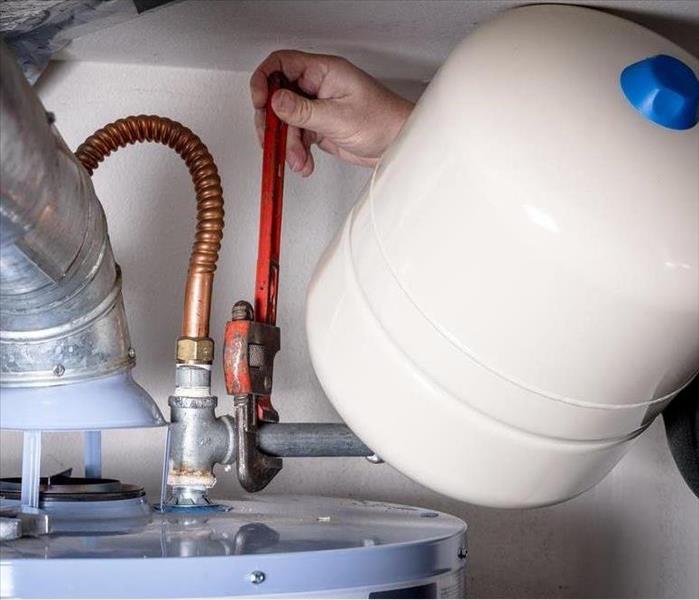 A leaking water heater in your home can happen without warning. SERVPRO can help you to prevent and restore!
A leaking water heater in your home can happen without warning. SERVPRO can help you to prevent and restore!
The Importance Of Water Heater Flood Mitigation
Floods can happen in your Lake Balboa, CA, home for a variety of reasons, but one you might not expect is a leaking water heater. Whether this appliance develops a steady leak or bursts all at once, it can cause considerable flooding. Taking quick action afterward by calling in a professional flood cleanup service may prevent further damage to your home and the costly repair bills that can come with it.
Immediate Safety Measures Implemented
Flood techs can inspect a failed water heater safely and prevent dangers that might cause serious harm to you and your family. The hazards of this type of failure can even cause death and may include the following:
- Scalding from hot water
- Electrocution
- Fire from shorted electrical circuits
Reducing the risk of these immediate dangers can protect everyone working to stop the flooding and give you peace of mind that your family is safe, despite the mishap.
Containment of Water
If a broken water heater bursts and causes a sudden flood, containing the water can be an important step in protecting the rest of your home. Quick mitigation may prevent water from entering rooms with carpeting or reaching electrical outlets in other rooms. This action may also provide additional protection to curious young children and pets. Flood techs may work to turn off the water first before they attempt to stop the water from spreading.
Removal of Standing Water
Even a few inches of water from a leaking water heater can cause damage to a room's walls and floor. If you store your water heater in your basement, shallow water can spread and ruin nearby stored items, such as precious handmade Christmas ornaments or boxed photos. Removing standing water quickly can prevent leaking water from causing long-term damage to your home and treasured items.
A leaking water heater in your Lake Balboa, CA, home can happen without warning. Acting right away by calling in flood mitigation professionals might help you prevent severe water damage and reduce the risk of danger to your family.
Caring for Water-Damaged Possessions
7/13/2021 (Permalink)
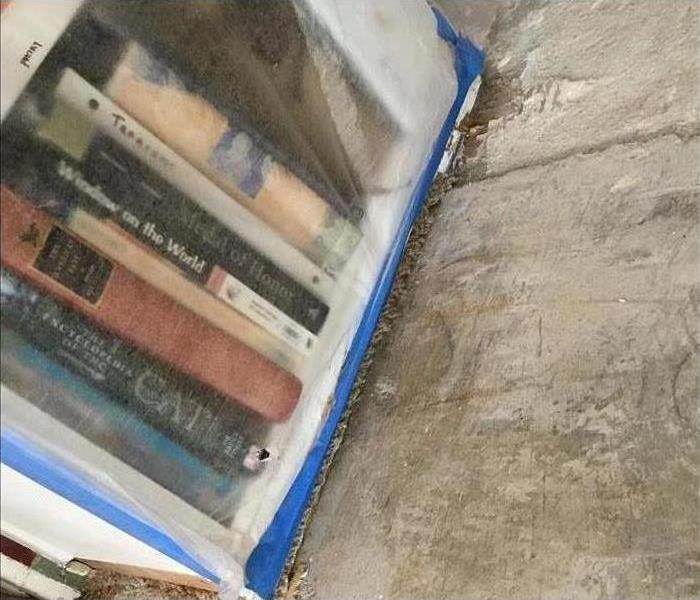 We will take care of your items like they are our own.
We will take care of your items like they are our own.
How Do You Clean Items Damaged By Water?
Water leaks and flooding can quickly harm your home as well as some of your most prized possessions. It is imperative to act quickly as you remove your items from any excess water in a home and begin to dry them. If you live in Valley Glen, CA, and have had any damage, the following four suggestions can help restore these objects to their original glory.
1. Rinse soiled items with clean water. Dab off any debris from the surface with a clean dry cloth. Make sure you are careful not to grind any particles further into the material. Dry cleaning can also help to remove any light residues that are visible on certain fabrics and materials. Place the drying objects away from any remaining water in the home.
2. Remove pictures, paintings, and paper from casings or holders. For example, take photographs out of frames and let both sides of the paper dry. Take books off of shelves and open them up, switching to different pages every couple of hours. Keep paper and paintings away from direct sunlight, as it might damage them further.
3. Hang or prop objects so they can dry completely on all sides. Soiled furniture should be propped on stable blocks. Allow fans and air conditioning to blow directly onto the items. Opening windows can also help reduce the amount of humidity in a wet room. Avoid attempting to repair or restore anything while it may still be damp on the inside.
4. Carefully handle electronics. Do not try to run any electronics that you think may have been exposed to moisture. Unplug the electronics if necessary, dry their external frames, and contact a professional restoration company. Qualified electronic technicians can tell you which pieces are still in working condition and which others might be salvageable.
Damage from excess water in a home can result from many different sources such as a leaking roof, a broken pipe, a faulty sink or toilet leak, or another natural flooding. Regardless of the water source, however, time is always of the essence when it comes to properly caring for these wet items.
What Are Some Signs That My Basement Has Water Damage? | SERVPRO® of Van Nuys South
5/25/2021 (Permalink)
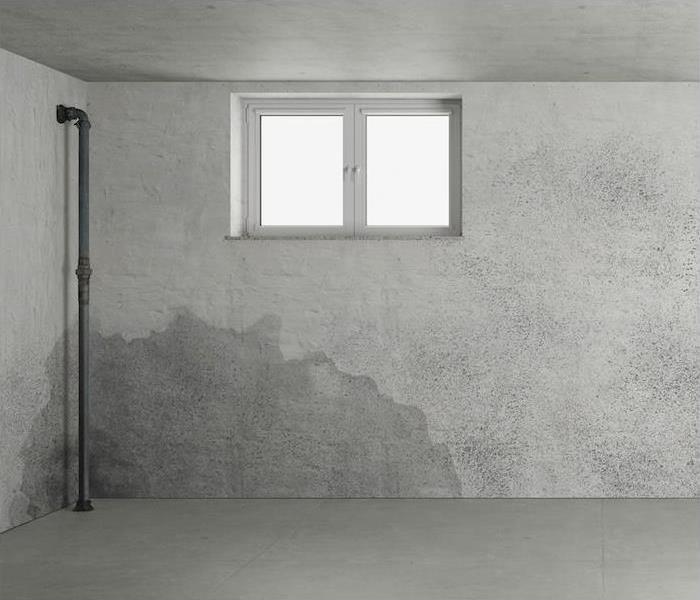 SERVPRO of Van Nuys South is a full restoration company. Our team of experts are on call and ready to help you determine the best course of action.
SERVPRO of Van Nuys South is a full restoration company. Our team of experts are on call and ready to help you determine the best course of action.
Basements can be a great, versatile space for your family home. They can provide anything from simple storage space to a music studio, from a movie room to an extra living room. And they’re so helpful as a storm and earthquake shelter that many homes in the greater Los Angeles area are being retrofitted with basements.
The downside of basements is that they carry the inherent risk of being both the lowest point in your home and a part of your home that is dug into the earth, making them a prime place for you to have to deal with water damage at some point.
While this is not a certainty, it is at the very least a likelihood. You would do well to keep abreast of the potential risks in your home for water damage, and to know the telltale signs that portend them.
Let’s take a look at the most likely water damage scenarios and how you can hopefully see them coming before they result in something major.
First Signs of Basement Water DamageUnpleasant, musky odors. Water gets into the basement by leaking in from outside soil or rain, or by indoor plumbing or appliance issues. Once it comes in, it soaks into surfaces and begins to allow bacteria to grow, causing a familiar musty odor that you could probably make yourself smell even as you read this. Many people have grown to believe this is simply the way basements and underground rooms smell, but that shouldn’t be the case. This smell will only arise when mold and mildew are present in the environment, and though you may not yet see them on walls or floors, the smell should tip you off that there’s a problem that needs to be addressed.
Flaking paint on masonry or walls. If your paint is bubbling or cracking, you can almost be sure there’s a water issue behind it somewhere that needs to be searched out. Even waterproof paints that kill mold and mildew can’t prevent water from coming through, and in fact they may merely mask a greater problem. If you see flaking and bubbling, water is almost certainly the culprit.
Foundational cracks. While homes have been known to shift over a period of years, a legitimate crack in the foundation requires immediate attention, and may be a sign of a significant water leak or loss under the house. Foundation cracks may manifest themselves inside the home as well: Cracks can show up in the floor, the ceiling or in your walls, a sign that a foundation crack is putting strain and lopsided pressure on the rest of your home’s structure. Hairline cracks inside are no cause for immediate alarm, but keep an eye on them to make sure they don’t increase in number or size.
If you notice any of these signs in your basement, let us take a look. Our expert water restoration technicians can help you determine what is causing these issues and how to treat it properly. Contact us today to learn more.
What Makes a Thunderstorm So Dangerous? | SERVPRO® of Van Nuys South
5/6/2021 (Permalink)
 Thunderstorms can pop up at any moment. Contact SERVPRO of Van Nuys South if you experience any damage.
Thunderstorms can pop up at any moment. Contact SERVPRO of Van Nuys South if you experience any damage.
California sees its fair share of beautiful weather, but we also see our share of inclement weather. Thunderstorms are common for this time of year, but some can be more dangerous than others.
What aspects go into the level of damage a storm can do? It varies from high winds to lightning to flooding, but ultimately it’s dependent on two main factors that turn the storm into a “severe” thunderstorm.
A thunderstorm is classified as a storm that has thunder, and since thunder is a byproduct of lightning, this is necessary to the makeup of the storm as well.
For a storm to be considered a severe thunderstorm, it has to have both hail and high winds in addition to lightning and thunder. The winds in a severe storm are at least 58 miles per hour and the hail is at least one inch in diameter.
3 Major Players in the Severity of a Thunderstorm
Damage from lightning strikes. Lightning strikes are certainly one of the most dangerous elements of thunderstorms, and it is reported that they cause around 300 injuries every year. This is not even factoring in the damage that lightning causes to property, specifically in the way of starting house fires and causing trees and limbs to fall on permanent structures.
Damage due to hail. Due to the size and speed of hail, it can cause damage to almost anything it impacts. In a severe storm, the hail is an inch in diameter or larger and it can bust windshields and dent unsheltered cars, put holes in shingles of a roof, and cause injuries to people, pets and livestock that are not adequately covered.
Flooding. Flash floods can occur any time under the right conditions, even if you’re not in a designated area that is prone to flooding. Even without the heaviest of rains, if a storm drain isn’t working properly or a small ditch by the road overflows with water, the roadway can quickly become flooded and be a very serious hazard for drivers.
Thunderstorms are capable of causing serious damage to homes or commercial spaces. If your property has damage due to a thunderstorm, you can contact us 24⁄7 for more information about our storm restoration practices.
Protect Your Home from Damage From Heavy Rains l SERVPRO® of Van Nuys South
4/5/2021 (Permalink)
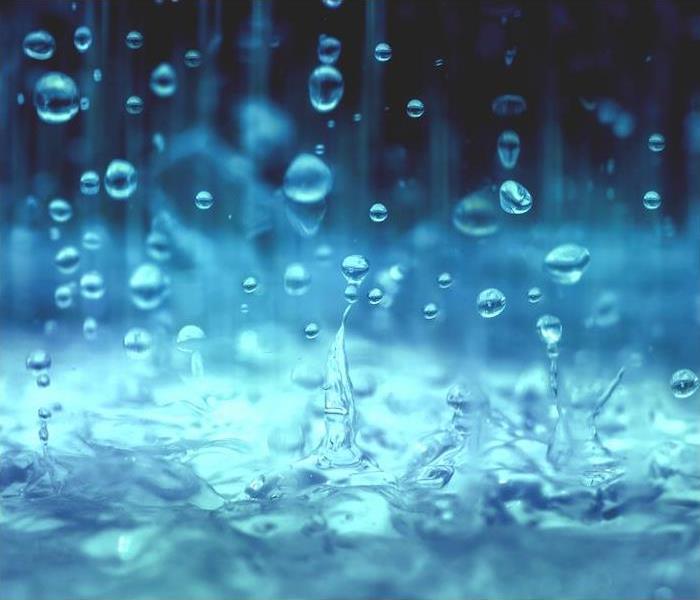 If you need help dealing with any damage caused by water, contact SERVPRO of Van Nuys South today.
If you need help dealing with any damage caused by water, contact SERVPRO of Van Nuys South today.
When asked how the water damage happens, many homeowners jump straight to some of the most obvious causes.
Those include problems like natural disasters—think floods and severe storms like tornadoes or hurricanes. Water damage can come from more mundane home problems, as well. A backed-up sewer or kitchen sink can be very damaging. So can a burst pipe.
Here’s something you might not have thought about when considering ways water can damage your home: heavy rains.
Keep in mind, this is a little different from the damage that comes from a flash flood. Heavy rain causes damage over time, and it can be so slow that homeowners don’t even notice there’s a problem until it becomes severe.
That’s why basic home maintenance is such an important task for homeowners.
Don’t Let Wet Weather Hurt Your Property
These projects will help you get your home maintenance plan moving in the right direction.
Choose plants, flowers and shrubs that will protect your home. Native plants are a great resource for homeowners because they can help stop water damage. Think of them as a way to both make your home more beautiful and protect it. If you don’t know a lot about plants that are native to our area, research the topic or visit a native plant sale.
Treat your yard like it’s a line of defense against water damage. Don’t allow water to pool in your yard or drain improperly. Instead, if you notice water moving toward your home instead of away from it, start working with a landscaping professional about ways to protect your yard.
Take steps to prevent roof leaks. Sealing your roof can help protect your home from wind and water damage. Experts estimate that almost 95% of water damage is caused by water seeping through gaps in your roof and shingles, which can be prevented with this step.
If you need help dealing with damage caused by water, fire or any other issue, we’re here to help you restore your home. We have crews who are available 24⁄7 in the event of an emergency. Contact us at any time to learn more about us and how we can help you restore your home to its original state.
Can You Find Signs of Water Damage in Your Valley Glen Home? | SERVPRO® of Van Nuys South
1/6/2021 (Permalink)
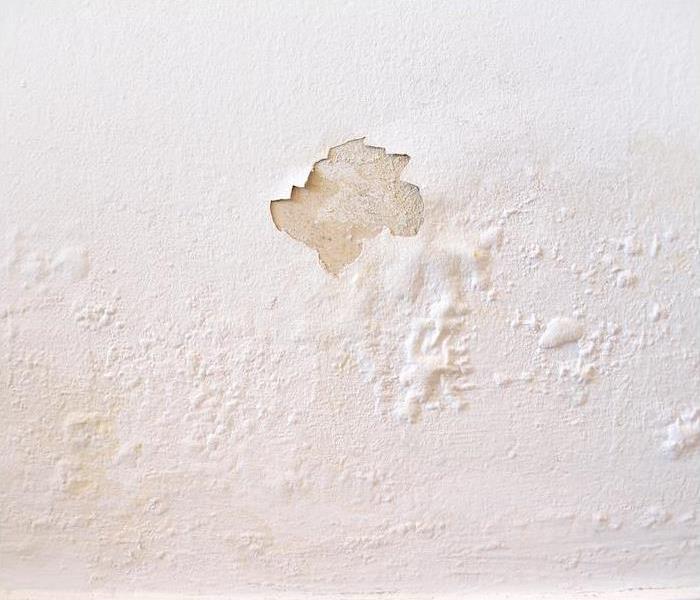 Do you have any water damage to your walls or ceiling? Contact SERVPRO of Van Nuys South, we will help guide you through the restoration process.
Do you have any water damage to your walls or ceiling? Contact SERVPRO of Van Nuys South, we will help guide you through the restoration process.
If your Van Nuys home has been restored after water damage, you aren’t alone. You’re one of the millions of other homeowners in America who had to seek restoration services. In fact, one in every 50 American homeowners has to file one of these claims each year.
The numbers are continuing to grow—even as fire damage claims are dropping each year. Insurance industry statisticians have found that water damage claims are continually among the most common that are filed each year.
Would you know the signs of damage in your own home?
Recognizing the Signs of a Major Leak
Homeowners struggle to know exactly when they should call in a restoration service. After all, getting a professional to evaluate a problem can seem like a big step. And it is. But it’s also necessary when the water has done damage that can’t be mopped up or cleared with a shop vac.
If you notice the signs below, it’s time to call in a professional to help you deal with water damage.
You notice wood warping in your home. The wood in your home will be among the first places you’ll notice the damage. That means your furniture, floorboards, doors and windows might start to warp, bubble or stain. This is a sign that your water damage needs professional attention.
Fabric, like curtains and upholstery, starts to fade or stain. Exposure to water damages fabric. If you notice issues with heavy fabrics (like your curtains), you’ll want to be sure and call for an evaluation.
You smell a musty odor. A musty smell can be among the first signs of mold damage. That means if you notice that scent, it’s time to call in a professional to repair your home. Mold damage worsens over time, so the sooner you get help, the easier it will be to remediate and restore the damage.
If you have water damage in your home due to a burst pipe or another cause, you can count on us for restoration assistance. We have teams who are available 24⁄7 in the event of an emergency. Contact us at any time to learn more about our restoration services.
Do You Know How to Recover From a Burst Pipe? | SERVPRO® of Van Nuys South
12/9/2020 (Permalink)
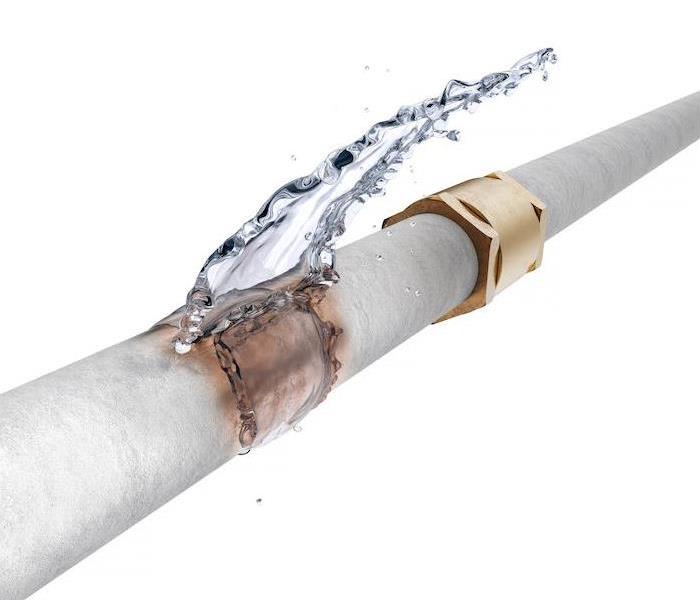 If you have water damage in your home due to a burst pipe, contact us right away. SERVPRO of Van Nuys South is available 24/7.
If you have water damage in your home due to a burst pipe, contact us right away. SERVPRO of Van Nuys South is available 24/7.
Having household damages is never a pleasant experience, especially if that damage is due to water that is a result of a pipe bursting. While there are many types of water damage that can cause risks, the sheer volume of water from bursting pipes makes it a difficult thing to contend with.
Though preparing for a scenario that is hypothetical may feel difficult, knowing how to react to water damage is so important. Out of every 50 households, one will have water damage each year, but planning ahead can significantly reduce the extent of the issues that occur.
Recovering From a Burst Pipe in Your Home
Shut off your water main. As water is continually ejected from a burst pipe, it can fully saturate the impacted area and cause significant damage. Finding and cutting off your home’s water main will put a stop to this, reducing the extent of the damage that is able to occur.
Shut off your electricity. If it is safe to do so, turning off your electricity from your home’s breaker box is key after a pipe burst. If water and electricity come into contact with one another, there can be risk of fire and electrocution in addition to the water damage dangers.
Contact your restoration company. Knowing what restoration company you will work with in advance is a great way to streamline the recovery process, as you can call them right away if you discover damages.
Take a record of the damages. Being able to keep thorough records is a great way to keep things organized, both on your behalf and on the behalf of your insurance company. Taking photos, videos and keeping a list can keep you from forgetting about anything amidst the chaos.
Contact your insurance company. Because there is so much variance in insurance policies and how the claims process works, it is best to get in touch with your insurance provider quickly so you are aware of the next steps.
Open windows and doors if possible. If you are able and it is safe to do so, opening windows and doors can be a great way to speed up the evaporation process in the impacted area as you wait for restoration help to arrive.
If you have water damage in your home due to a burst pipe or another cause, you can count on us for restoration assistance. Contact us at any time to learn more about our restoration services.
The Dangerous Conditions Surrounding Flash Floods | SERVPRO® of Van Nuys South
11/23/2020 (Permalink)
 SERVPRO of Van Nuys South is your local water & storm restoration expert. We will get the job done right, contact us today.
SERVPRO of Van Nuys South is your local water & storm restoration expert. We will get the job done right, contact us today.
Any type of severe weather scenario has the potential to cause danger for multiple reasons, but few present more risks than flash flooding. Flooding causes more weather-related deaths than anything except for heat in the United States, and flash floods are the deadliest of all the flood types.
If it is a possibility that a flash flood could happen, being aware of what to do is key, as you must act quickly to get out of harm’s way. Being aware of the speed of flash floods, the way you can find out if you are at risk and how you can safely evacuate can prepare you much more effectively.
What Causes Flash Floods to Be So Hazardous?
Any type of flood will cause a certain level of danger, but flash floods cause even more because of the speed with which they occur. After rain begins, a flash flood will occur within six hours, but often much faster, and can impact nearly any area where the warning was issued. For those in the flash flood’s path, quickly getting to safety is key so you are not caught up in the waters.
How Can I Determine My Flash Flood Risks?
Staying tuned into broadcasts from local weather officials will be the best source of real-time information in regards to the weather conditions. If a flash flood alert is issued, that simply means to stay alert and aware of changing conditions.
For a flash flood warning, begin evacuating and moving to higher ground with your family. If there is a flash flood emergency called, know that is extremely rare and get to higher ground via whatever means necessary.
What Safety Precautions Should I Know to Evacuate?
Acting quickly is key if you find yourself impacted by a flash flood warning, so knowing how to evacuate with safety in mind is so important. Here are some of the best safety tips to memorize beforehand:
- Get real-time updates from local weather officials through approved channels.
- Be sure everyone in your home is aware of your evacuation plan.
- Avoid attempting to cross areas that are flooded, even in the car.
- Stop children from touching or playing near floodwater.
- Know of multiple evacuation routes, as those blocked by water are impassable.
If your home or business has been damaged due to a flood or other severe weather, you can depend on us. Contact us at any hour to learn more about our services or to report damage to your property.
Where to Check for Water Damage in Your Home | SERVPRO® of Van Nuys South
9/21/2020 (Permalink)
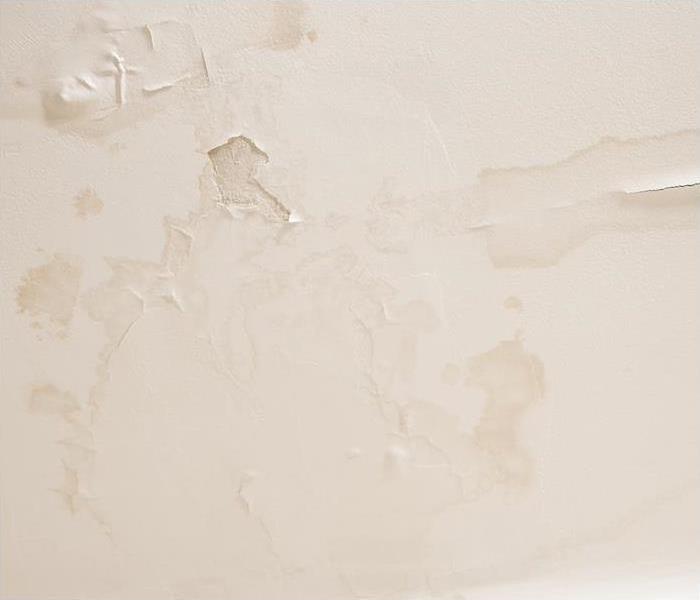 Do you have any water damage to your home? Contact SERVPRO of Van Nuys South, we are your local water restoration experts.
Do you have any water damage to your home? Contact SERVPRO of Van Nuys South, we are your local water restoration experts.
There are few better things to invest your time into than keeping your home maintained, and one of the best ways to do this is by checking often for water damage. Not only will cosmetic issues arise from moisture buildup, but it can also lead to serious structural issues in your home which will only get worse over time.
You can do your own checks for water damage around the house so you know as soon as you need to call in a professional. Catching water damage early can help lessen the damage it causes and lessen the amount you have to claim on your homeowners insurance for the damages, too.
Do Your Own Checks for Water Damage Around the House
Inspect your walls and ceilings. The drywall in a home is designed to conceal structural elements, but it can also conceal leaks and moisture buildup. Knowing what to look for is key to making sure your home is not harboring any hidden leaks. Peeling or bubbling paint, discoloration or spots that are soft to the touch are often indicators that something is amiss.
Don’t forget to look down. The floor of your home is set upon a subfloor, which provides a level base for it to rest on. However, these subfloors can absorb moisture if there is a leak, causing waviness or buckling as they swell and retain water. If you notice sudden issues with your floor, it is best to get a restoration crew involved quickly.
Inspect your roof. It is good to keep your roof in good shape, as it has the big job of keeping water out of your home every time it rains. You can learn a lot about your roof by simply going outside with binoculars to check for signs of damage and wear, such as loose or missing shingles, that could be indicative that water is working its way in.
Pay close attention to the basement. Letting your basement become musty is not just unpleasant—it can cause serious household issues, too. Water can seep in through your foundation walls or begin to infiltrate the basement with heavy rain, leading to mold and mildew growth in addition to structural issues with your foundation.
If you have water damage anywhere in your home, we are here to help. You can contact us at any hour to learn more about our services or to report damages. Get in touch today to speak with a water damage restoration expert.
A Few Key Safety Tips for Sudden Summer Storms | SERVPRO® of Van Nuys South
7/8/2020 (Permalink)
 Have you been affected by a storm event? SERVPRO of Van Nuys South is available 24/7 and ready to assist you with any storm damage.
Have you been affected by a storm event? SERVPRO of Van Nuys South is available 24/7 and ready to assist you with any storm damage.
If the skies are clear on a gorgeous summer day, you may not be thinking a bit about sheltering from severe weather. However, because summer storms are so sudden, it is important to know what to do no matter where a storm catches you.
These safety tips can help you find shelter and stay safe any time a sudden storm pops up anywhere you are.
Find Shelter and Stay Safe Any Time a Storm Pops Up
Know your options for shelter. Ideally, you will find out a storm is incoming while you are somewhere safe where you can wait out the severe weather, but this is not always the case. If a storm catches you when you are on the go, taking shelter in your car is recommended as long as you can do so safely.
Practice electrical safety. Thunderstorms always have the possibility to produce lightning, which can be dangerous even if you are in a building. Lightning sends electricity through a home’s wiring, which is not made to handle such high voltage. In turn, it will transfer this voltage to electronics that are plugged in, potentially ruining them. If you can, unplug everything nearby if a storm is inbound. For a long-term solution, surge protectors are a great option.
Avoid direct contact with concrete. Concrete buildings are sturdy, but they are sturdy in part due to the metal within their walls. This metal, when struck by lightning, can transfer the charge outward through the concrete and to anything against it—including people. It is best to avoid direct contact with concrete if you shelter in a concrete building.
Stay indoors for at least 30 minutes. When a storm interrupts your fun, getting back outside is top priority—but doing so too quickly can still put you in danger. Lightning has been documented 25 miles from storm clouds, so it is recommended that you wait at least a half hour after you can no longer hear thunder to head back out.
If your home sustains damage due to a storm, you can count on us to help. Contact us at any hour to learn more about our storm restoration process.
Where Water Damage Is Often Found After Rainfall | SERVPRO® of Van Nuys South
5/11/2020 (Permalink)
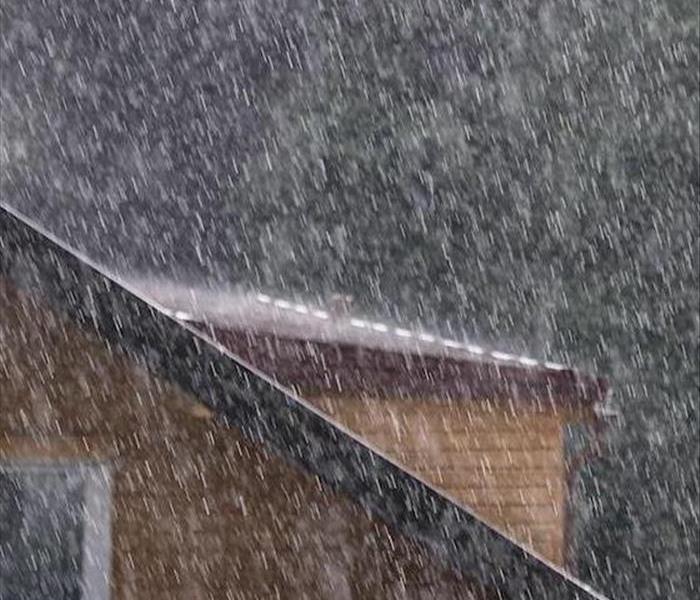 Heavy rains can cause serious water damage. SERVPRO of Van Nuys South has the trained technicians to fully restore your home.
Heavy rains can cause serious water damage. SERVPRO of Van Nuys South has the trained technicians to fully restore your home.
Water damage can be extremely disruptive regardless of the cause, but when it sneaks up on you, it can feel especially difficult to handle.
Many times, water damage is a result of heavy rain showers that come through the area, instead of being a result of flooding or plumbing issues. These leaks can occur covertly, but knowing where to check after heavy showers can help you keep an eye out.
Household Leaks That Can Occur After Heavy Rainfall
Around clogged gutters. Gutters are responsible for draining water away from your home, but if they are clogged past the point of doing their job, the water may not be able to drain away and can instead work its way into the roofline of the home.
Leaks around windows and doors. The seals surrounding the outside openings of a home are made to be impervious to leaks, but over time, they can wear down and allow water to work its way in. Discoloration, softening of the wood and warping are all signs that this might be happening.
Poor drainage around the foundation. When water is unable to drain away from the foundation, it can instead begin to seep inward into the block. There are many creative landscaping solutions that can help route the flow of water away from the home and prevent this.
Leaks in and around the roof. If conditions are right, roofs can start leaking early in their lifetimes, so it is never too soon to start checking them for signs that an issue may arise. Roof leaks can often be sneaky as they start with an attic space, so a visual inspection can help you be vigilant.
Malfunctioning of a sump pump system. The base level of most homes can benefit from having a sump pump installed, but it is important to take care of them as well. Pump malfunctions can arise from poor maintenance, leading to floods in the places they should be protecting.
Leaks around chimneys and skylights. The seals around anything that intersects with the roof can decay over time and begin to let water in, especially in the event of persistent rainfall. If you have things like this, they should be included with your roof inspection to watch for leaks.
If you’ve experienced water damage to your home, we are here to help. You can call us 24⁄7 to have our trained technicians respond quickly and begin your restoration.
Our 6-Step Process for Restoring Water Damage | SERVPRO® of Van Nuys South
4/16/2020 (Permalink)
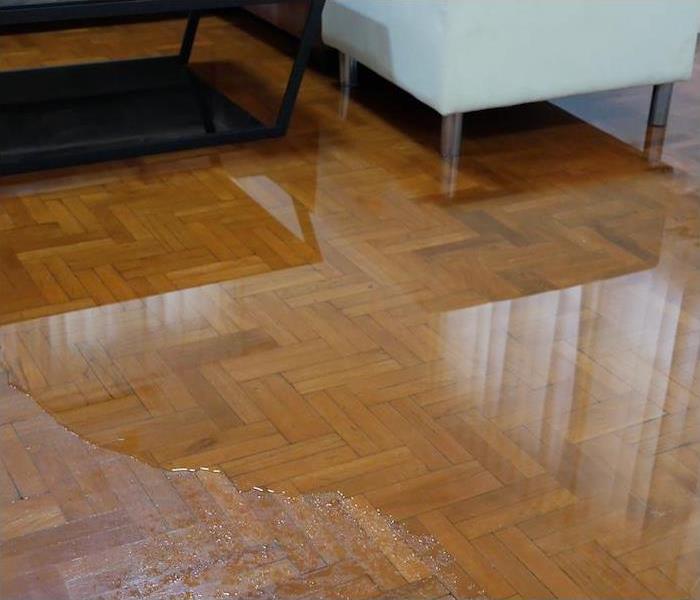 When dealing with water damage, immediate action is crucial. Contact SERVPRO of Van Nuys South for prompt & dependable service.
When dealing with water damage, immediate action is crucial. Contact SERVPRO of Van Nuys South for prompt & dependable service.
When you discover that you are the victim of water damage, it is important to quickly start the restoration process even though it is a devastating experience.
That is why we are here 24/7—whenever you decide to call us, you can count on our friendly service and proven process to help you recover. Here’s what we will do:
6 Steps to Water Damage Restoration
1. Initial Emergency Contact
As soon as you call us, you will receive help from one of our restoration experts in order to get the details regarding your damage so we can assemble the right response team to dispatch out to you. We are here 24⁄7 to take your call and take action.
2. Inspection and Damage Assessment
We take safety seriously, so we will establish that the scene is safe as soon as we arrive before proceeding. Following this, we will fully inspect and assess the damage that has occurred and create your custom restoration plan.
3. Moisture Extraction
We have some of the best equipment in the industry for extracting mass quantities of moisture quickly, which is exactly what you want when you are tackling water damage. We will start by moving out all the standing water to make room for our technicians to work on your surfaces.
4. Dehumidifying and Drying
Getting the moisture out as quickly as possible is always key, including from the air and from impacted objects. We will make sure that all surfaces are thoroughly dried to reduce the chances of mold and mildew growing in the aftermath of the water damage.
5. Cleaning Belongings
Following the dehumidification and drying of objects and surfaces, everything will be fully cleaned and sanitized. Doing this ensures that everything in your home is safe to use and will also prevent musty odors from permeating your household.
6. Restoration and Repair
We pride ourselves on being full service restoration professionals, meaning we handle everything from beginning to end. This means we can handle structural and cosmetic tasks once everything is dried out to truly make it like the water damage never occurred.
If your home has been water-damaged, you can count on us to help. Call us 24⁄7 to get the process started.
Taking Steps Toward Flood Recovery With Speed & Safety in Mind | SERVPRO® of Van Nuys South
4/9/2020 (Permalink)
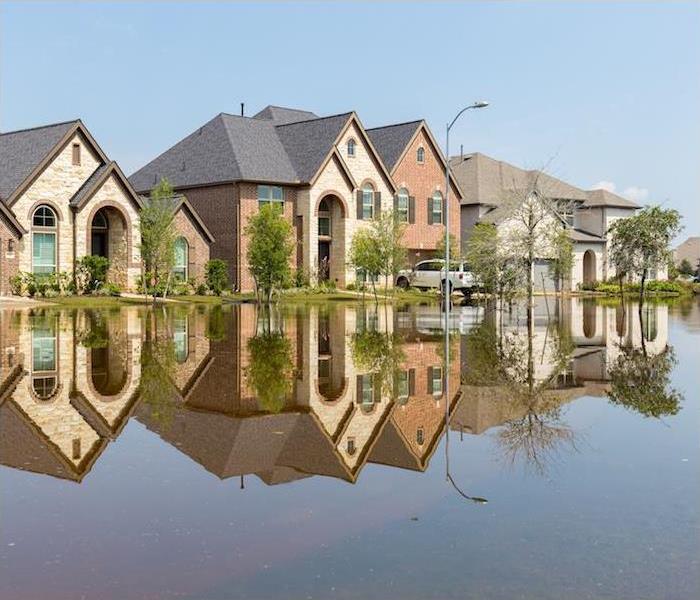 If you’re experiencng any water damage from flooding, SERVPRO of Van Nuys South is available 24/7 to assist with any repairs.
If you’re experiencng any water damage from flooding, SERVPRO of Van Nuys South is available 24/7 to assist with any repairs.
There has been an increase in flood-related damages in recent years, prompting many people to wonder what they should do in the event that they need to be concerned with recovery.
While speed is a priority when it comes to handling the aftermath of a flood, staying safe is also equally important as you do so. It is normal to want to get to work right away in cleaning up and repairing your home, so we have put together some tips to make sure you stay safe while you do so:
Taking Steps for Speed and Safety During Flood Recovery
Avoid further safety hazards. If you were ordered to evacuate, not knowing the damage done to your house can be difficult, but it is important to not rush home before you have been cleared to do so. There are many auxiliary dangers that can pop up after a flood, so emergency officials will need to inspect the area to make sure it is safe.
Air out the home. While water damage is a hassle on its own, after a flood, mold can begin growing within hours and lead to its own set of issues. Mold spores can take hold anywhere, but if you can open the doors and windows when you return to your home, you can increase the airflow and discourage the mold from landing on your belongings—plus, this will keep the air safer to breathe and decrease the adverse health risks that mold can pose.
Document the damages. Walking into your home and surveying the magnitude of the flood damage can be an overwhelming experience, and many people will want to start sorting through their items right away. We always recommend documenting the damages for your records first, however. Take thorough photographs of all impacted areas, and create an inventory list to keep track of everything that has been damaged before you make any changes.
Contact your restoration and insurance companies right away. For those who have a flood insurance policy for their household, talking to them about the claims filing process should be a high priority so you can get it started. Afterward, you can give us a call at any time—the longer flood damage is untreated, the worse it can become, so we guarantee that we can respond quickly and begin moving moisture out.
If your home has been damaged in a flood, we are here for you. You can contact us 24⁄7 to receive a quick response and set the restoration process in motion.
Methods for Increasing Household Weatherproofing | SERVPRO® of Van Nuys South
3/9/2020 (Permalink)
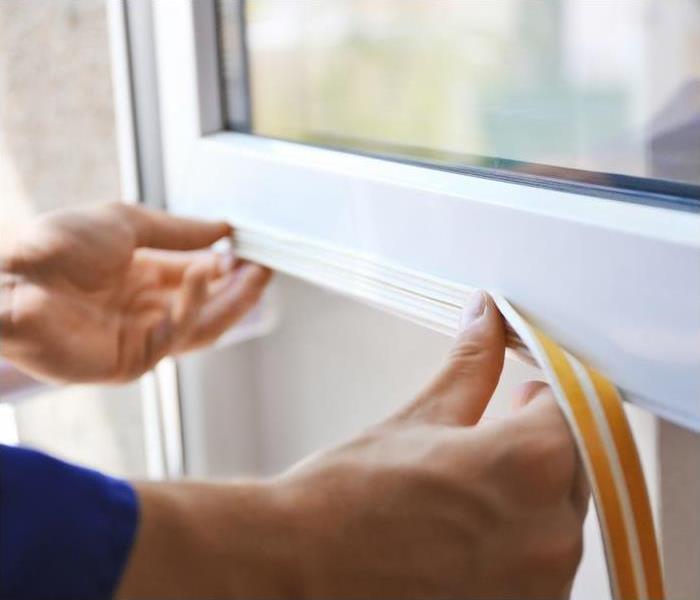 If you have any storm damage, SERVPRO of Van Nuys South is here to help. We are available 24/7 and ready to assist you when you need it most.
If you have any storm damage, SERVPRO of Van Nuys South is here to help. We are available 24/7 and ready to assist you when you need it most.
When you hear that severe weather is on the way, do you immediately begin worrying about damage to your home? While there is no way to guarantee you will not sustain damage, taking measures to increase your home’s weatherproofing can give you valuable peace of mind—and when you consider that half of insurance claims from homeowners are due to storm damage, it is something that is wise to avoid when possible.
For most homeowners, implementing weatherproofing efforts is something that only takes a weekend and can have serious benefits. Read on to learn more about our top recommendations for preventing storm damage to your home.
Increasing Household WeatherproofingKeep Your Shingles in Shape
Do not make the mistake of assuming your house is too new to have a roof leak. Roof leaks develop due to a variety of causes and can cause serious damage if left unnoticed. Check your shingles for signs of wear and tear and prioritize repairs to prevent excessive damage.
Beat the Weather With Weatherstripping
Weatherstripping is highly regarded not only for adding storm resilience but also for how well it insulates the home and saves on heating and cooling costs. Weatherstripping prevents water from working its way into microscopic cracks around doors and windows, and it can often be installed in an afternoon.
Gut Debris From Your Gutters
When your gutters are clogged, water can back up and begin to seep into places it should not be—namely, into your home. Clean your gutters at least every six months to prevent this from happening, and check them regularly for cracks, wet spots or any other signs that something is amiss.
Pick the Right Paint
Choosing an exterior paint is a decision that involves more than just coloring these days. There are paints engineered with extra weather protection now, from waterproof coating to UV ray-blocking technology. The next time it is time to add a coat of paint to your home’s exterior, consider choosing something of this nature to increase your home’s resilience.
If you have issues with storm damage to your home, we are always here to help. Contact us 24 hours a day for a rapid response.
Hidden Water Damage From Appliances | SERVPRO® of Van Nuys South
1/16/2020 (Permalink)
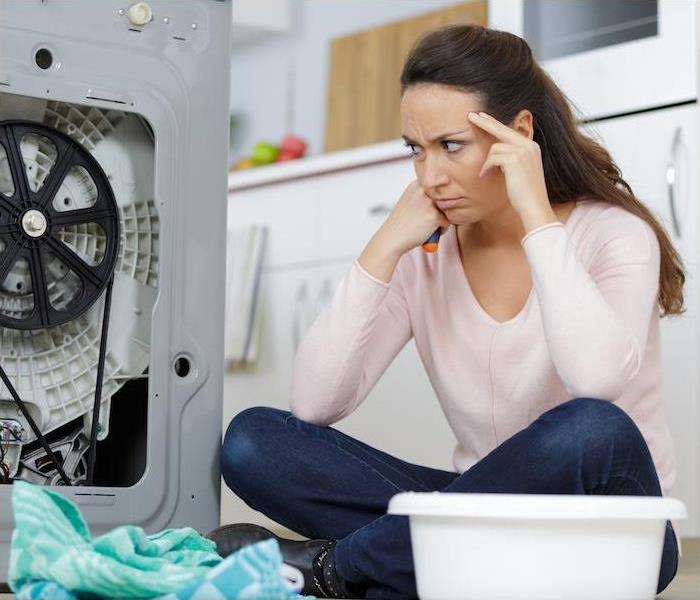 If your home experiences any flooding or other water issue, SERVPRO of Van Nuys South is here to dry, clean and repair any damage.
If your home experiences any flooding or other water issue, SERVPRO of Van Nuys South is here to dry, clean and repair any damage.
Any kind of water damage is alarming for homeowners to deal with. While some causes create apparent issues, when it comes to appliance leaks, there may be extensive damage before the problem is discovered.
Fortunately, by making sure that you are checking up on the right appliances and putting the proper prevention measures in place, you can help prevent this hidden damage from occurring.
Check These Appliances for Household Water DamageHot Water Heater
A well-maintained hot water heater can last up to 15 years, but leaks from the components and pipes may start much sooner. Checking the seals and pipes surrounding the heater is important, as well as monitoring the drain pan to ensure any accumulated water is being drained away sufficiently.
Refrigerator
Because they are not frequently moved, refrigerators can harbor hidden water damage for years before it is brought to light. Ice and water dispensers are connected to a home’s main plumbing system, and if there is any issue with the seals or tubing, leaks can occur and compound with time. Making it part of your home maintenance checklist to check behind the fridge is wise.
Dishwasher
The same things said about refrigerators can be said about dishwashers, but dishwashers are an even higher risk appliance. They use quite a bit more water, and insurance coverage of their damages is not guaranteed. To avoid a large and expensive problem, check behind the dishwasher just as often as you check the fridge.
Washing Machine
The hoses that run to washing machines are common leak culprits and should be inspected monthly to ensure there are no issues. Because these hoses can also deteriorate from the inside out, it is recommended that they are replaced at least every five years to avoid hidden damage.
Air Conditioner
An HVAC system will typically drain water away as it operates, ensuring that any condensation it creates does not become backed up. However, water damage to and around the unit can occur if there are issues with this drainage system. Regular maintenance is one of the best preventatives—your manufacturer should have frequency guidelines so that you can be made aware of any issues before they turn into water damage problems.
If your home has been impacted by water damage or you’d like to put a plan in place in case it happens to you, contact us to learn how we can help.
Do You See What I See
8/28/2019 (Permalink)
There are a couple things we hear almost every time when arriving on a water damage job.
"It's OK, everything will dry on its own."
Or, worse . . .
"Everything is dried up. Nothing is wet."
With the first statement at least the property owner is acknowledging that the building materials are - or may be - wet. However they are misinformed. Building materials will not dry by themselves, at least not quickly enough. It's the reason that fully half of our business consists of mold remediation. We do mold remediation when the building materials don't in fact dry up quickly enough, and mold grows. We would love to take these customers to the current mold remediation jobs that we have ongoing at any given moment and they'll realize that, in fact, building materials don't dry by themselves quickly enough, and that is why we have to do mold remediation.
The second comment is more concerning because the customer isn't even acknowledging and sometimes isn't willing to learn that the building materials are indeed wet.
This is when the capabilities of a professional, experienced water damage mitigation expert can be of benefit. We at SERVPRO ofVan Nuys Southpossess the equipment that will help identify what building materials are wet and what building materials are not wet.
We are happy to come out to our community at any time and help a property owner know whether or not they have water damage. It isn't always obvious – many times you can't even tell a wall is wet until you start smelling nasty odors or seeing mold colonies form on the building materials.
The moisture detection equipment we possess allows us to identify whether or not materials are wet, and where exactly they are wet. They are allowing us to mitigate and dry the structure quickly and precisely in a rifle-shot manner. One example is in the picture below – infrared cameras help us quickly scan an area that has come under attack by a water damage. Water is tricky and will find its own way to make it down to lower floors. In this photo we see that the water has clearly come from above down a certain vein. Only a small section of this wall was affected. This precision diagnosis allowed us to attack this small area quickly efficiently and cost-effectively, eliminating the risk of a costly and potentially harmful mold situation.
Ignorance is bliss. Except when it isn't. When it comes to water damage, ignorance can cause unnecessary and preventable property deterioration, which can powers financial hardships or worse yet harm to the health of building occupants.
You Need Our Crew At SERVPRO When Your Van Nuys South Home Requires Water Cleanup Services
8/13/2019 (Permalink)
A Comparison Of What Can Happen With Or Without SERVPRO In Van Nuys South
Water damage to your Van Nuys South home can be a complete disaster, but with the help of professional damage mitigation services like SERVPRO, you can overcome both immediate and long-term problems with relative ease and minimal costs. However, if you choose to skip out on a certified restoration service, you could end up with much more serious issues that take significantly more time and money to fix. If you have more questions about what SERVPRO can do to help your issues and how much your insurance can cover, get in touch with one of our representatives.
What Happens With Help?
With the help of a company like SERVPRO that is certified to restore your Van Nuys Home after water damage makes its mark, all signs of the damage should be eliminated within a few weeks for even the most extensive problems. Many smaller restoration procedures take only a few days, but the result is the same: your home looks just as good as and possibly better than it was before the incident took place. We remove any water remaining in the building, dry your home out down to the deepest reaches of its materials, and then work to repair any structural or cosmetic damage the moisture may have caused to your home.
What Happens Without Help?
If you choose to go without the aid of a professional damage restoration service, the problems can add up and cost you much more in the long run. Excess water can seep into the foundation and structural elements of your home, breaking them down and necessitating expensive reconstruction efforts. On top of that, your home could also develop a mold problem, as fungal spores grow quickly and easily in climate controlled environments with plenty of moisture and humidity. You might still end up making a call to us, but for a much more involved and costly set of issues.
SERVPRO of Van Nuys South helps homeowners around the Valley and Greater LA take care of their finances and belongings after a water damage incident occurs. Call us 24/7 at (818) 780-71111
Did You Know There Are Three Types of Contaminated Water?
8/9/2019 (Permalink)
At SERVPRO of Van Nuys South we understand that water damage could strike at anytime. Our local North Arlington technicians are ready to respond to your emergency 24/7!
In the U.S alone it is estimated that over 14,000 homeowners rush to deal with water leak emergencies every day. It is important that you know the source of the damage when you call your local SERVPRO of Van Nuys South. Because without knowing the source of the damage it is difficult for our technicians to decipher how to assess and repair the damage. To avoid a longer repair time knowing the category and source of the leak or damage is instrumental in restoring your property to pre-disaster condition.
Did You Know There are 3 Types of Contaminated Water?
When your local SERVPRO of Van Nuys South is called you will be asked a number of questions such as; do you know the source of the damage? How severe is the damage? And with this information we will then categorize the damage type and prepare your repair plan with in minutes!
The Three Types of Contaminated Water
Most home or business owners are unaware that there are three types of contaminated water. These three are broken up into categories depending on the source.
Here are the three types of contaminated water:
- Category 1: "Clean Water"- Clean water is from "clean" source such as a broken water line. A category one water damage originates from a source that does not contain waste. This category is less severe as it presents less risks for humans conducting the restoration.
- Category 2: "Grey Water"- Grey water is water that may contain bacteria and viruses. Harmful, if consumed by humans and may cause sickness. Examples of category grey water include dishwater, washer water and more.
- Category 3: "Black Water"- Black water is extremely unsanitary and harmful to humans. Black water may contain untreated sewage, harsh chemicals and microbes. Examples of black water are sewage backup and flood water.
If left untreated these categories may degrade.It is imperative that water damage is treated immediately. Time is of the essence when a disaster hits. Our local SERVPRO of Van Nuys South technicians are standing by 24/7 to help!
If your home or business is suffering from water damage call your local SERVPRO of Van Nuys South 818-780-7111
SERVPRO - Quick And Professional Water Removal For Van Nuys/ Sherman Oaks Homes
7/15/2019 (Permalink)
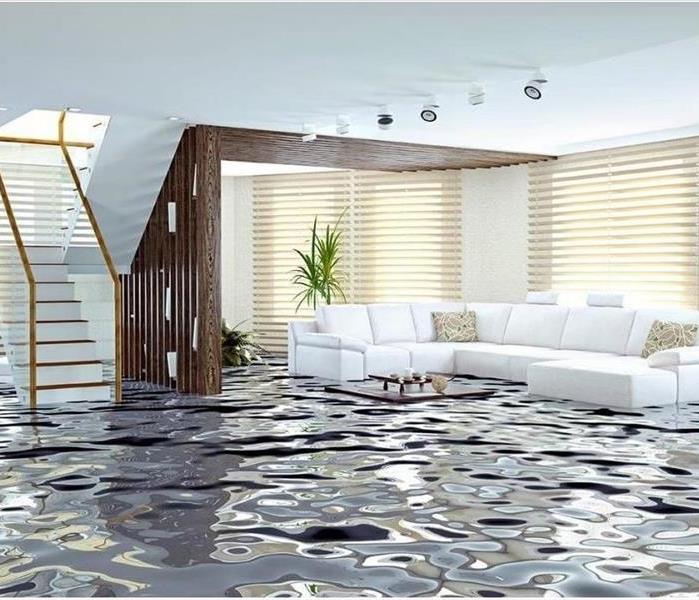 Flooded Kitchen and Living Room
Flooded Kitchen and Living Room
Van Nuys is not a regular recipient of the flooding that follows a massive storm or another severe weather event. Common water intrusions here are the results of a broken inlet pipe, failed dishwasher, or another faulty, plumbing issue. If not handled quickly, though, a bad water heater can cause as much damage as severe rain.
Water removal from a Van Nuys home needs to be accomplished quickly to reduce the effects of water in the home and to prevent further damage. SERVPRO response team technicians train on a variety of equipment to remove amounts from knee-deep to just barely covering the kitchen floor.
Team members start with submersible, commercial-grade water pumps. These devices can empty a single room of visible water in a few hours and even a mini-mansion in a day or two, depending on many are needed for the task.
Once the pumps complete their work, technicians then switch to water extractors. They can adjust the vacuum speed and heat of these devices to carefully draw water off every type of surface from wood floors to deep pile carpeting without splintering floorboards, or separating the carpet layers.
For concrete and linoleum floors, SERVPRO response teams can use long-handled squeegees to push water off the surface and out the nearest exit, or toward another technician with an extractor to draw it out of the home.
After contacting us, it is best to stay out of the home. Floors and carpets underwater are more dangerous to walk across and to attempt to move property, especially large furniture can lead to accidents that cause more damage to your home and property. It is far safer to wait for us to remove water and then relocate all property from the affected parts of the home.
Our task at SERVPRO of Nuys South is to return every home to a dry, safe condition as quickly as possible, and use every tool available to reduce or eliminate the effects of any water intrusion. If you need our assistance, call our office today at 818-720-7111
Methods to Protect Your Home From Flood Damage
7/11/2019 (Permalink)
Considering that flooding is associated with 90% of natural disasters, it is prudent for homeowners to consider their risks, even if they do not live in a known flood zone.
Protecting Your Home From Flood DamageHomeowners will never be able to prevent disaster-related floods altogether, but they are able to take steps to limit the extensive damage a flood may cause:
Know your risk. Use the Flood Map Tool provided by FEMA to research your particular area and understand what risks you face. Additionally, make a call to your local emergency management authorities in order to learn how floods are handled in the community.
Have a conversation about emergency procedures. Discussing a disaster plan and evacuation route with everyone in your family will ensure everyone knows what actions to take should an emergency occur. Show all household members where to turn off electricity supplies and make sure emergency supplies are easily accessible.
Digitize valuables. Precious and irreplaceable items, such as family memorabilia, tax records and household documents, should be digitized and the physical copies kept off-site or in a waterproof safe.
Protect appliances. In the case of a shallow flood, appliances such as washers and dryers can be elevated on bricks or stands to protect the internal workings from water damage.
Elevate hazardous materials. Hazardous materials can leach into flood water and cause pollution and even fire risk. Any cleaning chemicals or other hazardous household waste should be sealed and elevated to alleviate risk.
Turn off electricity. Water and electricity do not mix—that is why it is essential to turn off the electricity in areas of the house that are flooded. This can be done by using your main breaker box or calling the electric company in most cases.
Anchor fuel and propane tanks. A tipped fuel tank can lead to a dangerous spill or even a fire, and floodwaters can often be the cause. Remove fuel tanks from the property or anchor them securely.
While thinking about floods is not pleasant, it is essential for keeping your home and your family safe in these disaster scenarios. Plan ahead to protect your belongings and your loved ones.
If you’ve experienced flood damage or water damage from other causes, SERVPRO® of Van Nuys South is here to help. Our technicians are fully trained in water remediation, and our 24⁄7 Emergency Line means we’ll be there for you when you call.
Do You Know How Floodwaters Are Classified? | SERVPRO® of Van Nuys South
5/15/2019 (Permalink)
Water damage situations are not all created equal when it comes to the water that is involved. There are three different classifications for that water: clean water, gray water and black water. If you have an understanding of the differences in these types of water, you will then understand how to better handle the situation.
There will always be a cleanup and restoration process to go through regardless of what type of water has caused damage. The most important step to take is to get all of the moisture and damp items out of your home or building quickly, so mold will not have an opportunity to grow and flourish in its ideal environment.
<h4water">Clean Water
The description of clean water is basically what its name infers. Clean water is free of contaminants and is not the type of water that will pose an immediate threat to your health. It is generally a byproduct of:
- Broken water lines
- Malfunctioning appliances
- Toilet holding tanks
- Snow melt and rainwater
Clean water will be the easiest type of water damage to clean up after because there will be fewer microbes living in this water. But you only have a 48-hour window of opportunity, because after that time and after the water has had contact with the surfaces of a building, it becomes gray water.
<h4water">Gray Water
Water from dishwashers, aquariums, showers, etc. are examples of gray water. When gray water is involved, water damage cleanup and restoration can become a bit more serious as it is water that may pose a health risk due to it containing chemical or biological contamination.
The slight contamination in gray water means that it will need to be thoroughly treated before being safe to consume. Here, again, the 48-hour exposure time applies here as it will turn into black water if not property treated.
<h4water">Black Water
Black water is the most dangerous of the three types of water and is highly contaminated by harmful chemicals and biological matter, including floodwaters containing soil and all sewage waters.
Sewage is known to be contaminated with microbes, including bacteria, protozoans, molds, fungi and more—many of these can be harmful to humans.
Some of the diseases that can be transmitted by black water are:
- Cholera
- Typhoid
- Hepatitis
- Gastroenteritis-type illnesses
Remember to treat all floodwater like it is black water since it will pick up contaminants as it travels along its path.
These three different classifications of floodwater are recognized by the Institute of Inspection, Cleaning and Remediation Certification (IICRC), an organization that certifies and sets the standards for the cleaning and restoration industries. Our technicians all study IICRC standards and best practices in water restoration and are available to help determine the steps to take to get your home back to normal.
It doesn’t matter what type of water has caused damage to your home or business, SERVPRO® of Van Nuys South is here to help get the situation under control and make it "Like it never even happened." Don’t hesitate to reach out to us if you need emergency cleanup and restoration services!
Prepping Your Family for Severe Weather | SERVPRO® of Van Nuys South
5/9/2019 (Permalink)
While there is advanced warning for some types of severe weather, there are also those occasions where there will be no advanced warning and we will be caught off-guard.
Fortunately, there are steps to take and safety tips to check out that will ensure your family is prepared for these severe weather occurrences.
The Importance of Planning for Severe WeatherPutting together an established family emergency plan is one of the best ways to begin preparing your family for these weather situations.
If your family does have an emergency plan in place, be sure to practice and review it at the beginning of each season so it is fresh in everyone’s mind.
If you’ve not yet created a family emergency plan, here are some ideas to take into consideration when creating your plan:
1. Receiving emergency alerts
Thanks to today’s technologies, it is easy to receive emergency alerts and warnings on your smartphone that is equipped with Google or a weather app. These technologies enable you to quickly receive emergency alerts, which can provide you with valuable time in severe weather situations. But don’t forget warnings and alerts are also broadcast over radio and TV.
2. Evaluating storm shelter options
Establish a place to take shelter if you live in an area where tornadoes are common. lt’s best to choose a basement or, if there is no basement, an interior room on the lowest level that is away from windows and doors. There are other reasons a shelter should be designated, and by visiting ready.gov you can learn more about this.
3. Mapping out evacuation routes
You should always have several routes mapped out that can serve as an evacuation routes. Hurricanes, flooding and fires can force you from your home in a hurry, and it’s wise to have multiple routes should one route become impassable. Also find out if there are places to stay with your pets along the way if you have furry family members to evacuate with.
4. Communicating during a storm
Communication is key, so it’s only natural to rely on cell phones to keep in touch with your family, but there will be times when that will not be possible. Cell phone towers can damaged leaving you without a signal, there could be no power leaving you unable to charge your phone, or cell phones could be lost or left behind.
So, your family will need an emergency communication plan in place and a safe meeting place for your family so that you can all meet there if separated.
If a storm does cause damage to your home or business, don’t hesitate to call your friends at SERVPRO® of Van Nuys South to get the cleanup and restoration process started.
Water Damage and Restoration
8/7/2018 (Permalink)
With many of the properties making up the Van Nuys neighborhood being constructed quite sometime ago, Many have experienced water damage caused by failed water pipes, air-conditioning units leaking, cracked water pipes from overgrown trees and earthquakes.
Since we typically cannot see these water pipes it is difficult to conduct any sort of maintenance before the leak presents a problem and we notice it after the fact. What’s worse is if you live in a condominium unit on the bottom floor, your neighbor above you could have a leak that will also affect you even if your pipes have no damage whatsoever.
When water damage affects our home it affects our lifestyle and causes anxiety and discomfort. SERVPRO Van Nuys South knows this fact and because of that we do our utmost to get in and get out leaving you with the feeling as if it never even happened.
The Pollution Types Relating to Water Damage | SERVPRO® of Van Nuys South
7/17/2018 (Permalink)
You can’t escape terms like “black water” and “clear water” when talking about water damage and the pollution left behind, but what do they mean? Though it’s true that black water is hazardous, there are actually three types of water damage that can all cause problems.
Because we know the devastation that lies in the aftermath of water damage, we’ve outlined the water contamination types you might encounter so you can be informed.
Classifications of Water DamageCategory 1: “Clear water,” which is the first level, refers to water originating from a source free of contaminants (aka clear). Water from leaky faucets, direct rainwater, broken inbound pipes or water supply lines are all categorized this way, and category 1 water should not pose health issues if consumed.
Category 2: Grey water, the second category, is a bit more serious. This is wastewater generated from appliance or drain overflows, as well as other types of household flooding. This water is often contaminated on its own and/or has come into contact with a variety of surfaces. Therefore, category 2 water is somewhat contaminated and can cause illness if consumed.
Category 3: Category 3 water is the most notorious and is commonly known as black water. Rising flood waters, sewage overflows or water that has begun breeding bacteria due to stagnation are all cause for concern. Black water can also lead to illness or death if consumed.
Categories Can Be DynamicWater damage continues to become more complicated after the initial flooding because water that starts as one category can quickly advance to another. Water that develops higher pollution levels from coming into contact with surfaces and/or breeding bacteria can become even more dangerous as time progresses.
Because this is impossible to determine solely based on appearance, professional water restoration is essential to obtaining peace of mind and a properly restored property.
If you’ve fallen victim to water damage, SERVPRO® can help! Our team of water damage professionals can get your place back to normal, faster.
Van Nuys 24 Hour Emergency Water Damage Service
5/4/2018 (Permalink)
SERVPRO of Van Nuys South is available 24 hours a day for water emergencies, large or small. When you are dealing with water damage, immediate action is crucial. A delay of just a few hours can greatly increase the severity of the water damage.
We Answer the Phone Ready to Help
Call Today - 818-780-7111
We understand that when you call us, you may be feeling confused, stressed, and vulnerable. You need an expert to guide you through this crisis. SERVPRO of [[Franchise Name]] has the specific water damage training and experience to help you through this tough time. We specialize in water damage restoration—in fact, it's the cornerstone of our business.
What to Expect
When you call, we will ask several questions regarding your water damage emergency. These questions will help us determine what equipment and resources to bring, including how many trained SERVPRO Professionals may be needed.
Our SERVPRO Representative will ask several questions:
- Your name and contact information
- Your insurance information (if applicable)
- The street address of the water-damaged home or business
- When did the flooding or water damage occur?
- What caused the water damage (if known)?
- Is there electricity available (on-site)?
About SERVPRO of Van Nuys South
SERVPRO of Van Nuys South specializes in the cleanup and restoration of residential and commercial property after a fire, smoke or water damage event. Our staff is highly trained in property damage restoration. From initial and ongoing training at SERVPRO’s corporate training facility to regular IICRC-industry certification, rest assured our staff is equipped with the knowledge to restore your property.
 Have water damage in your home? Contact SERVPRO of Van Nuys South for quick and professional restoration.
Have water damage in your home? Contact SERVPRO of Van Nuys South for quick and professional restoration.





 24/7 Emergency Service
24/7 Emergency Service
























